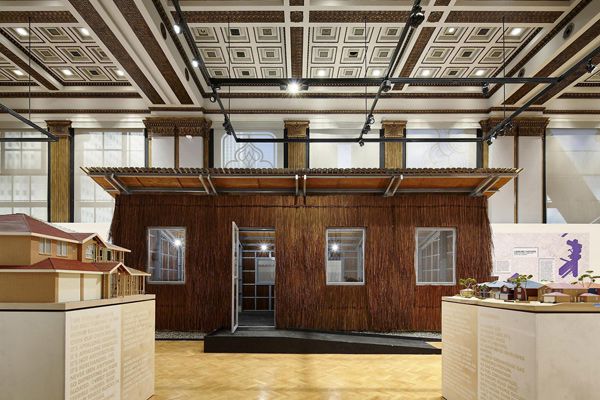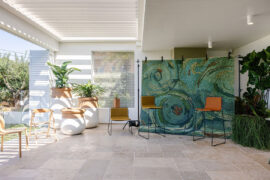Could renovating McMansions provide the key to sustainable living? Naomi Russo chats to otherothers’ Grace Mortlock and David Neustein about the possibilities of the Offset House.

March 16th, 2016
Hero Image: Copyright Tom Harris
Not many designers envision their projects as something for DIY-aficionados to undertake in the suburbs of Australia. However if a suburban resident transformed their McMansion into otherothers’ Offset House, the designers would be thrilled. The project, the only Australian design to be featured at the 2015 Chicago Biennale, is intended as a provocation, a comment on ways that the belittled burbs can become both beautiful and socially responsible.
Taking away the outer cladding, the Offset House showcases the stick framing at the core of most project homes, showcasing what Grace Mortlock and David Neustein identify as “modernism’s most successful and long-running project”. The zone between the outer and interior frames becomes a veranda, cutting back on the climate-controlled space within the home.
“The vast majority of Australians live in air-conditioned boxes” says Mortlock, arguing that the relationship between environmental needs and architecture has been lost. “The very early settlers’ architecture evolved’, Neustein adds, with buildings “responding to problems in certain ways”. That relationship of necessity, he believes, has been lost.
As suburban homes equal out in price with city apartments and utility costs rise, some ageing Australians are stuck in their homes, the design duo argue. The Offset House could also be an antidote to some of those concerns, opening up the possibility for co-habiting or subdividing. It, or something like it, could also provide a solution to the growing number of young people unable to afford a home. “We’re dealing with a diminished set of expectations” says Neustein. In response, he adds, architects “need to find ways to work effectively despite limitations.”
Part of answering these problems, the pair believe, is overcoming the historically difficult relationship between suburbs and architecture. Neustein sees this often troubled relationship as somewhat cyclical. Developers “produce buildings far more cheaply than architects can touch” he says, which has meant repetitions of similar styles with no architects involved. In response, he adds, there has been a “rearguard action” where the suburbs became known to architects as irredeemable. If sustainable living is to be achieved however, the suburbs – where most Australians live, need to be considered.
Nevertheless, two are quick to add that the Offset House was not conceived as the sole answer to all these weighty problems. Instead, with its bold design and openness to possibilities, it’s intended, Neustein says “as a way of raising a set of certain issues.” The pair plan to continue discussing these concerns, with an exhibition at RMIT focusing on sustainability and architecture planned for later this year.
Other Architects – otherothers
otherarchitects.com/otherothers
INDESIGN is on instagram
Follow @indesignlive
A searchable and comprehensive guide for specifying leading products and their suppliers
Keep up to date with the latest and greatest from our industry BFF's!

CDK Stone’s Natasha Stengos takes us through its Alexandria Selection Centre, where stone choice becomes a sensory experience – from curated spaces, crafted details and a colour-organised selection floor.

Welcomed to the Australian design scene in 2024, Kokuyo is set to redefine collaboration, bringing its unique blend of colour and function to individuals and corporations, designed to be used Any Way!

Featuring beloved Melbourne designers, this is a must-attend conversation for emerging designers and anyone interested in the pursuit of creativity.

Tackling 130 years of experimentation across art and design, MoMA at NGV has been possible through careful collaboration between two leading institutions. And the results are set to inspire.
The internet never sleeps! Here's the stuff you might have missed

Tappeti’s latest rugs have been unveiled at one of Luigi Rosselli’s stunning Sydney coastal homes alongside furniture by Design Nation.

Sydney Open invites the public to explore over 55 buildings, spaces and new additions to the skyline, with a newly released Talks & Tours program offering direct access to the architects behind Bundarra and Pier Pavilion.